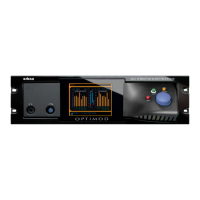OPTIMOD SURROUND PROCESSOR OPERATION
3-43
ing to unnaturally high levels.
There are two independent silence-gating circuits in each of the 8685’s processing
chains. The first affects the AGC and the second affects the multiband compressor.
Each has its own threshold control.
AGC Idle Gain on page 3-44 explains how the AGC gate’s no-signal gain is deter-
mined.
AGC Bas
s Coupling
control sets the balance provided in the AGC between bass
and the rest of the frequency spectrum.
The AGC processes audio in a master band for all audio above approximately 200 Hz
and a bass band for audio below approximately 200 Hz. The gain reduction in the
B
ASS audio path is either the output of the Bass compressor sidechain or the output
of the Master band sidechain. The AGC
BASS COUPLING control sets the switching
threshold. For example, if the AGC
BASS COUPLING control is set to 4 dB and the mas-
ter gain reduction is 10 dB, the bass gain reduction cannot decrease below 6 dB even
if the gain reduction signal from the Bass compressor sidechain is lower. However,
the audio path bass gain reduction can be larger than the master gain reduction
without limit. In the previous example, the bass gain reduction could be 25 dB.
A typical setting of the AGC B
ASS COUPLING control is 0 dB, which allows the AGC
bass band to correct excessive bass as necessary but does not permit it to provide a
dynamic bass boost.
Advanced AGC Controls
The following AGC controls are found only in the Advanced Modify screen and in
8685 PC Remote.
AGC Window Size
determines the size of the floating “slow zone” window in the
master band of the AGC. (The Bass band is not windowed.)
The window works by slowing down changes in the AGC gain reduction that are
smaller than the W
INDOW SIZE. The window has 2:1 asymmetry around the current
AGC gain reduction. For example, if the W
INDOW SIZE is set to 4 dB, the window ex-
tends 4 dB in the release direction and 2 dB in the attack direction.
If the AGC needs to respond to a large change in its input level by making a gain
change that is larger than the window, then the AGC’s attack and release controls
determine the AGC’s response time. However, if the change in input level is smaller
than the window size, the W
INDOW RELEASE control determines the attack and re-
lease times. This is usually much slower than the normal AGC time constants. This
prevents the AGC from building up density in material whose level is already well
controlled.
The previous explanation was somewhat simplified. In fact, the window has “soft
edges.” Instead of switching abruptly between time constants, the attack and re-

